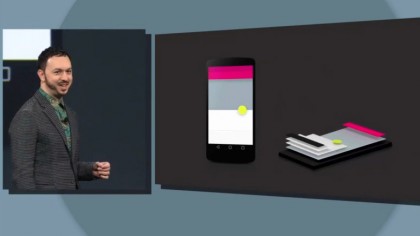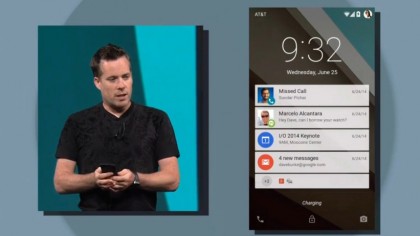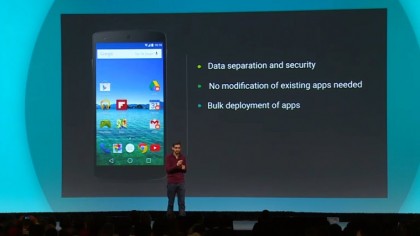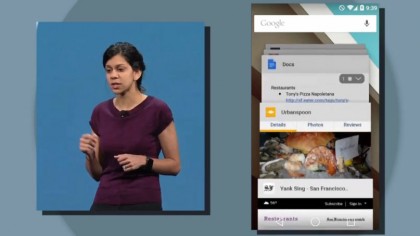Android L vs Android 4.4 - what's new?

Head of Android Sundar Pichai took to the stage at Google IO 2014 to deliver one of the biggest overhauls of Android yet - a whole new look and some big changes under the hood too.
Sadly, it's only a peek at the new OS, as Google tries to appease manufacturers who think launching new versions of Android later in the year ruins plans to get the new platform on handsets for the holidays... but there's still enough to get worked up over.
Android L not only marks a breakaway from Android naming tradition, that of sugary treats, but comes packed with over 5000 new developer APIs that help mark Android L as the "biggest release in the history of Android".
So what exactly makes this update so big and so important, and more importantly why should you be pining for the letter L rather than the chocolate goodness of Android KitKat?
User interface
The biggest change that users will notice is the whole new design language that has been developed with Android L introducing design guidelines that have previously been missing from the Android ecosystem.

Known as Material Design, Google's new interface has been created "not just for mobile but for form factors beyond mobile" said Pichai.
Android 4.4 KitKat and previous iterations suffer from a mishmash of app designs; the Gmail app differs largely from the messaging app which in turn differs largely from Facebook. Instead the new guidelines offer up a way of making the whole device feel unified.
Sign up for breaking news, reviews, opinion, top tech deals, and more.
This new design also brings an almost 3D effect, offered as Android L now enables developers to add an elevation value to any UI surface which will come rendered "in correct perspective with virtual light sources and real time shadows"
Put simply, developers can now make it seem that certain elements are floating above the rest of the app with shadows reflecting where those elements are making Android L more intuitive than the flat Android KitKat.
Developers will also have access to a new grid layout, a key that will allow apps and websites to be more easily scaled between smaller smartphone screens up to larger tablet, even desktop monitors, and will ensure that every Google product, from the smallest smartphones to tablets, chrome books and even Android enabled TVs feel like a complete ecosystem.
This was previously a lot harder leading to apps on KitKat varying greatly between devices, with the same app on an Android 4.4 tablet looking different to that on a KitKat smartphone.
Also built in are a whole new raft of animations available to all apps that make moving throughout your Android L device seem more seamless where KitKat often feels disjointed. As Google put it, no more teleportation - everything will seem much more interconnected.
Notifications
Another key area that has been looked at is the way notifications have been handled. Up until now the notifications have been locked to the notifications bar, with the last real update coming in Ice Cream Sandwich where users could swipe to dismiss updates.
On current KitKat devices the only way you can access notifications is by pulling down the bar, allowing you to view and react. Instead, Android L brings these interactions far more front and centre, from less intrusion to new ways to see them.

This is most noticeable whilst receiving a call or a message whilst actively using your device; playing a game, for instance.
When receiving a call in KitKat, users are greeted by the call screen, therefore taking you out of the app you are in, swallowing the entire screen and forcing you to accept or reject the call.
Android L is far more subtle but is all the more useful for it, instead bringing down a 'Heads up' notification in much the same way as iOS. You can then dismiss or reply immediately without disruption.
Notifications have also been given pride of place on the Android L lock screen in a bid to make receiving and responding more seamless.
The effect that this will have on many Android KitKat users remains to be seen, as Android overlays such as Sense or TouchWiz and third party apps such as Qualcomm's Snapdragon Glance already offer this functionality.
Those using Nexus devices and Google Play editions will find this a lot more useful though, and Google has also packed in functionality that has been omitted on many lock screen replacements.
Android L will learn from your habits enabling it to prioritise the notifications that are most relevant to you, so avid tweeters will see Twitter notifications pushed to the fore, for example.
Security
Google believes 15% of Android users use a PIN or pattern lock on their device, and it wants to help cut down the time needed to open the phone. It claims that Android is being used regularly on over 1 billion phones, with average user checking their handset over 100 times a day so time saved unlocking can only help.

Android KitKat has many ways of protecting your device, with pattern unlocks, PINs and passwords, even Google's (all too often inaccurate) facial unlocking. Therefore a KitKat device will only unlock itself to those that know the correct password but this can be time consuming and often frustrating if you press or swipe incorrectly.
In order to reduce the time spent entering PINs and pass codes, Android L comes with 'personal unlocking', a feature that "enables the device to determine if it's in a trusted environment, [like] the owner's hand or beside the owner on a table".
This is worked out by pre-designated locations, any visible Bluetooth devices such as a smartwatch or even through your voice print. For those that have been looking over their shoulders at the ease of TouchID on the iPhone 5S or the fingerprint scanner on the Galaxy S5, this could prove a real blessing.
Android L also comes packing universal data controls allowing users to better see what data is shared with who. Where on KitKat you had to go through each app manually to discover which ones had access to sensitive data such as your location, Android L brings these under one roof.
This will give security conscious users the ability to choose who is getting access to things like location data in a way that they haven't before.
Speed
Whilst Android comes with some nifty new features that make an immediate visual impact, Google has put a lot of work in behind the scenes to ensure that Android L is the fastest yet. If you're not into code-speak, here's the summary: it's built on a new platform that's way more efficient than before and runs much faster.

ART was made available in Android KitKat as an optional runtime but has now been made the standard for Android L and has been developed to work with ARM, x86 and MIPS platforms, running twice as fast as the Dalvik runtime that is found on previous Android iterations.
The biggest benefit to users comes that this won't require apps to be readjusted in order to benefit, instead all apps will benefit from ART right away. ART is also more memory efficient than Dalvik meaning that apps that are running in the background will benefit from megabytes of saved data.
ART is also 64-bit compatible, where Dalvik on Android KitKat and lower only worked with 32-bit chips, allowing Android L to benefit from the larger number registers, cross platform support and the increased RAM support that 64-bit architecture supports.
Improved Graphics
As mobile GPUs have evolved, so has the mobile gaming industry although the last real mobile graphics boost that Android saw was with 4.3 Jelly Bean with the addition of OpenGL:ES 3.0 support.
At the time, EA Labels president, Frank Gibeau commented "In the near future, the next wave of tablets and phones will have nearly Xbox 360 or PS3 capabilities in terms of graphics."
To a certain extent he was right as Android KitKat brought along some pretty impressive gaming capabilities; think Shadow Gun Dead Zone rather than Flappy Bird.

Android L looks to build upon the work already done by Android Jelly Bean and KitKat bringing with it the sole task of closing the gap between mobile and desktop-class (DX11) graphics. This has been done by work with Nvidia, Qualcomm, ARM, and Imagination Technologies Google leading to the creation of the Android Extension Pack.
Technically speaking this means a set of features that includes tessellation, geometry shaders, computer shaders and ASTC texture compression which will result in "more realistic environments, more realistic characters and vastly improved lighting".
Overall Android L will bring far more powerful graphics capabilities to Android, exceeding what is currently available in even the most high-end Android KitKat games.
Interlinked apps
The way Google search interacts with your Android L device has also been taken a look at. Searching before was a lot more hassle, with Android L looking to streamline the process.
Using the KitKat search bar allows you to search the web and your device for certain details, although has always defaulted to bringing up the website address. Android L changes all of this with far greater app indexing making your Android L device more intuitive.

Android L allows users to search through apps directly from the search bar, whether it be a restaurant in the OpenTable app or a friend's page via Facebook
The 'Recents' pane of Android L has also been reimagined to fit in with Google's new Material design, but also comes with far greater functionality. In Android KitKat it is possible to fire up into multitasking and flip through the recently accessed apps, but that is as far as it goes.
With Android L, Google Chrome tabs are now listed within the multitasking pane, something that has previously been unavailable. This won't just be limited to Google Chrome though, as many Android L apps will also be able to open up multiple cards.
This will all save time as you'll no longer have to load up an app like Chrome and then navigate through; instead you can go directly to where you need to be.
Battery life
Finally Android L is also helping OEMs by extending battery life through Project Volta. This brings two main power-saving elements to Android L: opening up the data and extending battery life through a low-drain mode.
Android KitKat brought over Project Svelte, aimed at making the Android experience less memory intensive. This might have brought some battery improvements, but Project Volta has taken this to a whole new level.
Where Project Svelte was designed to make Android KitKat as a whole run on less powerful devices, Volta allows developers to target individual apps. The creation of the Battery Historian tool allows them to measure battery drain corresponding to exactly what was going on the device.
Developers can then rewrite code to counter that battery drain thereby making Android L apps more power efficient than on Android KitKat.
This has been backed up by a new Job Scheduler API , allowing Android L to "make your application more efficient by allowing the platform to coalesce non-urgent network requests from multiple apps".
By doing this, Android L can significantly reduce the amount of time that the Wi-Fi and cell radios are on compared to the Android KitKat equivalent, thereby reducing the amount of drain these have on the battery. Combined, Android L should make a battery last a lot longer than its older brother.
The second battery saving feature that Google has brought across is a battery saving mode. This might seem familiar; this is something that is now fairly common, appearing on the likes of the Samsung Galaxy S5 or HTC One (M8).
Nexus users will finally reap the benefits though, with the new mode allowing the CPU clock speed to be reduced, refresh rate to be lowered and data to be turned off. Google claims that this mode will extend the battery life of a Nexus 5 by about 90 minutes in a typical day